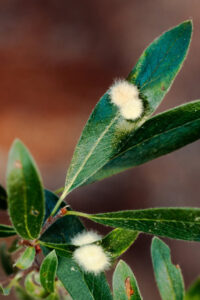Weird little bumps on leaves and funny lumps on your plant’s foliage might indicate bacterial, fungal, or pest issues. There are about as many gall types as there are causes. Identifying leaf galls is tricky since a lot of them look alike. Leaf galls are usually named after their tree type and confined to one genus or family of plant.
Causes for Leaf Galls
Leaf galls are typically the result of mites, making their homes beneath the plant tissue. Chemicals discharged all through egg growth in saliva or excretions might create the changes to plant tissue.
These modifications might not be just bumps on leaves. Fruits, flowers, and roots can cultivate these changes in tissue. Also, leaf galls are on trunks and stems. Other reasons are because of bacterial and fungal diseases.
What Leaf Gall Looks Like

Furry galls on willow leaves
When it comes to identifying this issue, even the most experienced and knowledgeable gardener might wonder how galls look. The appearance is usually as a peak, bump, or scabby spot of plant flesh. They are solid to the touch, and they might be thickly coating a plant.
These balls on plants could be green and correlate with the plant material. Leaf galls may be bright red or pink, resembling huge pimples.
Several galls like nipple, pouch, blister, bud, and roly-poly, refer to their looks. Some, like oak tree galls, refer to the plant affected. Others get their name from the spot affected. These are leaf, twig, flower, bud, and root galls. It is vital to know how to treat leaf gall.
Treatment
It is simpler to stop these from happening than to provide treatment once they are there. Treatment is typically not recommended. These are harmless, and any chemicals used might do more damage than good.
Give the plant excellent and accurate tree care to stimulate vigorous health. The best way to avoid this issue is to pick plants resistant to the most predominant varieties in your zone.
Ask Mechanicsburg Tree Service when you need a tree inspection for any kind of issue.


Recent Comments